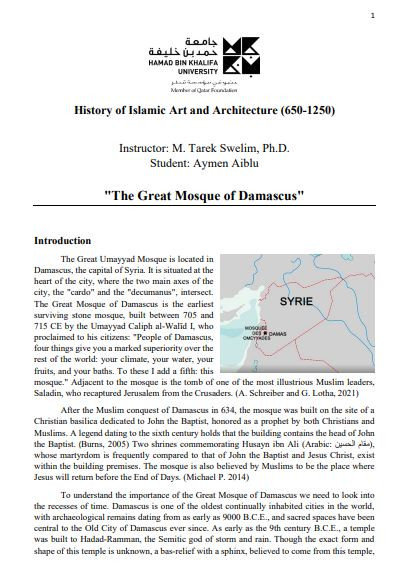
The Great Umayyad Mosque is located in
Damascus, the capital of Syria. It is situated at the
heart of the city, where the two main axes of the
city, the “cardo” and the “decumanus”, intersect.
The Great Mosque of Damascus is the earliest
surviving stone mosque, built between 705 and
715 CE by the Umayyad Caliph al-Walīd I, who
proclaimed to his citizens: “People of Damascus,
four things give you a marked superiority over the
rest of the world: your climate, your water, your
fruits, and your baths. To these I add a fifth: this
mosque.” Adjacent to the mosque is the tomb of one of the most illustrious Muslim leaders,
Saladin, who recaptured Jerusalem from the Crusaders. (A. Schreiber and G. Lotha, 2021)
After the Muslim conquest of Damascus in 634, the mosque was built on the site of a
Christian basilica dedicated to John the Baptist, honored as a prophet by both Christians and
Muslims. A legend dating to the sixth century holds that the building contains the head of John
the Baptist. (Burns, 2005) Two shrines commemorating Husayn ibn Ali (Arabic: الحسين مقام ,(
whose martyrdom is frequently compared to that of John the Baptist and Jesus Christ, exist
within the building premises. The mosque is also believed by Muslims to be the place where
Jesus will return before the End of Days. (Michael P. 2014).
I agree to the terms outlined below:
You agree to upload and assign Mosqpedia Database the rights to use the content worldwide and in perpetuity across all current and future media platforms. Mosqpedia Database may edit, copy, adapt and translate your contribution.
The content will be distributed under the Creative Commons Attribution-Deed – Attribution-NonCommercial-NoDerivatives 4.0 International – Creative Commons
All data will be stored in line with data protection regulations.